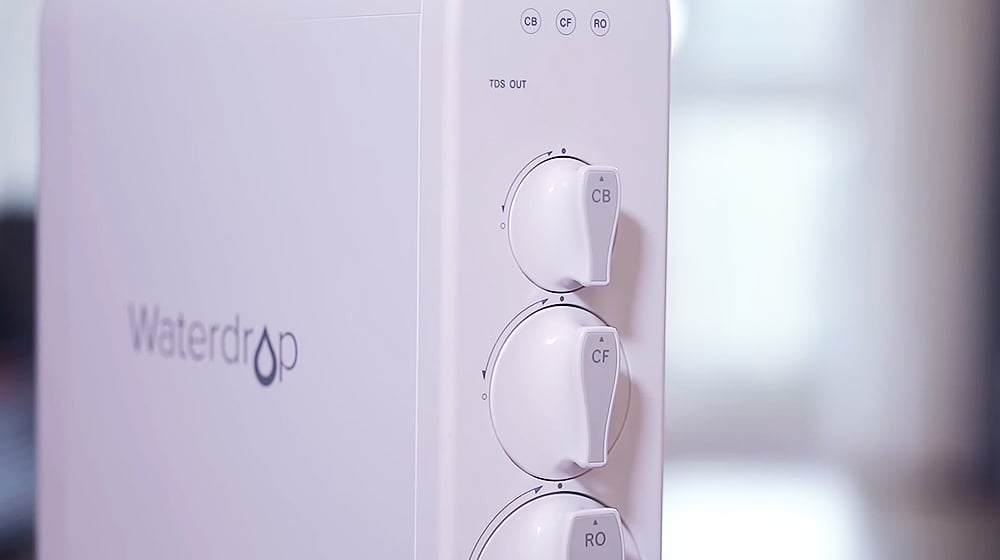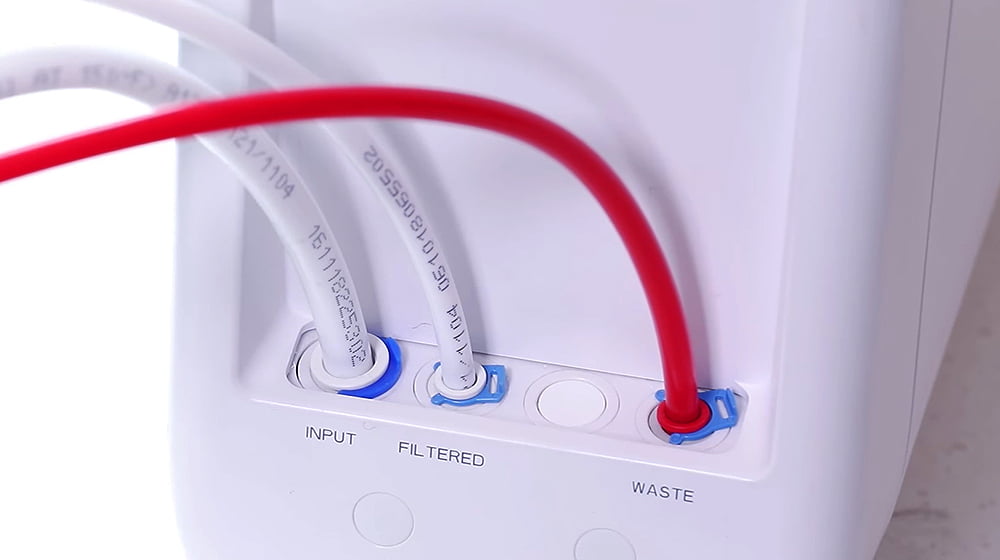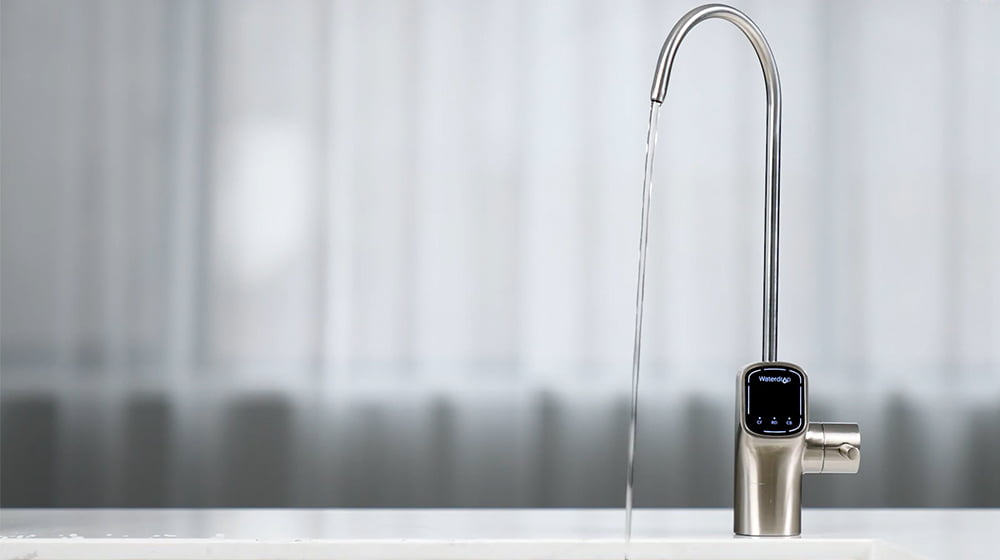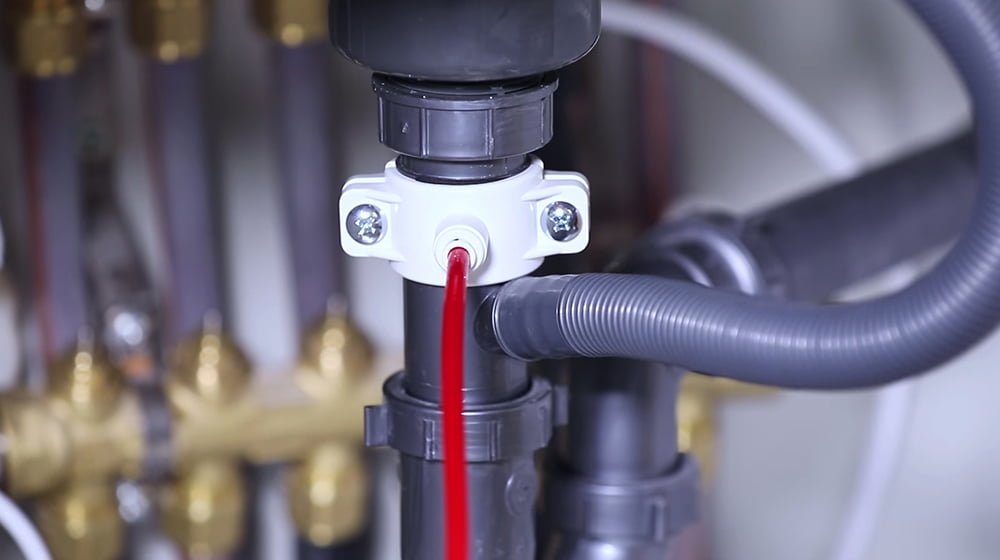Review: Waterdrop G3 Reverse Osmosis System (G3P600)
Written by: Alexandra Uta // Expert Fact-Checking: Buddhini Dolapihilla, MBSS // Last Updated: Aug 4, 2023
This page may contain affiliate links. If you buy a product or service through such a link we earn a commission at no extra cost to you. Learn more.
The Waterdrop G3 Reverse Osmosis System comes in different versions. This review features the Waterdrop G3P600.
It’s a tankless under sink RO system which means it filters water on-demand instead of storing it in a bulky tank. This saves quite a lot of space and, although not that important, it looks better, too.
On top of this, in order to provide water safe for drinking the Waterdrop G3 removes dozens of harmful contaminants.
Want to learn more? Continue reading!
Waterdrop G3 Reverse Osmosis System – All Specs
- Model: G3P600
- Last Price: $539.00
- Annual Maintenance Cost: ~$145
- Filter Media/Process: Sediment, 2x Carbon Block, RO Membrane
- Filter Stages: 4
- Flow Rate: 0.42 gpm
- Membrane Rating: 600 gpd
- Recovery Rate: 66%
- Filtering Capacity: 550-2,200 gal
- WxHxD: 5.67″x17.72″x18.12″
- Weight: 32.4 lb.
- Water Temperature: 41-100 °F
- Water Pressure: 14.5-87 psi
- NSF Certifications: NSF/ANSI 58 for TDS Reduction, NSF/ANSI 372 for Lead-Free Materials
- Warranty: 1 Year
Waterdrop G3 Discount Code
You can use our code “WD10BOS“ to get 10% off when you purchase the Waterdrop G3P600 on waterdropfilter.com.
Waterdrop G3P600 – Key Features
Most importantly, the Waterdrop G3P600 Reverse Osmosis System uses the following filter layers/stages:
- Composite filter (CF), 3 layers – First a composite filter uses 2 polypropylene cotton and one coconut shell activated carbon block filter layers to remove chlorine, bad taste and odor, sand, rust, and other larger solids.
- Reverse osmosis membrane – With a pore size of 0.0001-micron, the reverse osmosis membrane rejects just about everything a typical RO membrane rejects: Lead, chromium 6, mercury, arsenic, bacteria, viruses, and much more.
- Carbon block filter (CB) – Lastly, an activated carbon post-filter block gives the water a finishing touch improving aesthetics and removing leftover organic chemicals.
Filtration performance is backed by NSF certifications/testing – more on this later.
As the name suggests, the G3P600 is rated at 600 gallons per day which equals a flow rate of 0.42 gpm. Although this is a theoretical value and real-life water production is usually a bit lower, it is still plenty of water.
You also get a smart faucet that displays output water TDS and reminds you when to replace filters. The same feature is found on the system itself.
Filters last between 550 and 2,200 gallons or 6 to 24 months.
Lastly, there is a 30-day satisfaction guarantee and a 1 year warranty.
Side note: Two other versions of the G3 are the G3400 rated at 400 gpd and the G3800 (800 gpd).
Alexa’s Video Review
Being part of the BOS team, Alexa has ordered and tested the Waterdrop G3 Reverse Osmosis System, which means she has installed the system with her own hands and used it for several weeks for some genuine first-hand experience! Alexa has documented the entire process, including her findings and personal verdict, in the video provided below. Just note that this is a review of the original Waterdrop G3 (which is almost identical to the G3P600 except for the lower flow rate):
Waterdrop Reverse Osmosis Pros
More pros:
- Foregoing a bulky tank allows for more free room under your kitchen sink.
- Waterdrop reverse osmosis systems were designed with a DIY install in mind. #moneysaver
- An internal pump increases water pressure. 0.42 gallons per minute water flow rate means you never run out of purified water. If you do the math, you get 1 cup of RO water in no more than 8 seconds. No long waiting times!
- The pressure pump also reduces the amount of wastewater that goes down the drain. While a standard RO model wastes 3-5 gallons per 1 gallon of filtered water, the Waterdrop G3P600 only waste 0.33 gallon.
- The plastic is BPA-free to avoid contamination and the dispenser is metal for durability.
- Speaking of, the smart faucet tells you when to replace filters. When the LED light is white, your filters should be working just fine. The light turns yellow as soon as the remaining filter capacity is less than 40 gallons or 15 days. You’ll also hear 2 beeps when dispensing water. If you see red light and hear beeping you need to change one or more of the filters immediately. Similar lights are found on the RO system itself. All in all, you don’t have to worry about when to replace filter elements.
- What’s more, both faucet and system have a TDS monitoring panel which tells you at a glance how effective the filters, and the reverse osmosis membrane in particular, currently are.
- Replacing filters is incredibly easy. There’s no need to shut off the feed water or disconnect anything. Each cartridge can be removed and installed with a single turn – completely tools-free!
- And finally, Waterdrop offers a money-back satisfaction guarantee that allows you to return your unit within the first 30 days after purchase for a full refund. Plus, there’s a 1-year manufacturer warranty but only when the system is used on municipal water!
What Contaminants Are Being Removed?
Here is a list of contaminants that the Waterdrop G3P600 reverse osmosis water filter system can remove:
- Overall TDS
- Chlorine taste and odor, chloramine
- Sediments, turbidity
- Chromium 6, cadmium, lead, mercury, and other heavy metals
- Radium 226/228, aluminum
- Cysts and bacteria
- Arsenic and fluoride
- Organic chemicals including PFAS, asbestos, BPA, and VOCs
- Scale
- And more!
The Waterdrop G3P600 – learn more on Waterdropfilter.com
Installation
Waterdrop says their under sink reverse osmosis systems can be installed within 30 minutes. We think 1-2 hours is probably more realistic – still fast!
You shouldn’t have any problems completing the project if you’re handy around the house and have the necessary tools. Just follow the provided instructions. Most importantly, you’ll need a drill for the hole to accommodate the extra faucet (unless there already is a second hole in your sink or countertop) and you also have to drill into your drain pipe for the drain line connection.
You’ll need these tools to do all that and install the system:
- Variable speed drill
- Adjustable wrench/pliers
- ¼” drill bit for drain pipe
- 1″ drill bit for the faucet hole
- Scissors or utility knife
- Flashlight
- Towel
- Screwdriver
Now, follow these steps to install your Waterdrop G3P600 system.
- Turn off your cold water supply under the sink.
- Drain any remaining water by turning on your kitchen faucet.
- Remove the cold water pipe from the supply valve.
- Connect the feed water adapter to the cold water supply valve.
- Connect the cold water pipe to the feed water adapter. Ensure to use an adjustable wrench to tighten all the new connections.
- Fix the RO faucet to a second hole on your sink.
- Install the drain saddle.
- Set up the RO housing.
- Connect the INPUT, FILTERED, and WASTE water tubings.
- Connect the power cord to the faucet connector behind the filter housing. Also, connect the power adapter to the back of the housing.
- Insert the filters into their respective holes.
- Turn on the water supply valve and check for leaks. If there are none (or after you’ve fixed any leaks), plug the power adapter into the socket.
- Wait for the system to flush automatically for about five minutes.
- Open your RO faucet and let it run for about 30 minutes.
- Confirm again that there are no leaks, and start enjoying your Waterdrop filter.
Video
The Package (Parts)
- System housing
- WD-G3-CB filter element
- WD-G3-CF filter element
- WD-G3P600-RO filter element
- Smart digital faucet
- White 1/4″ PE tubing (60″ length)
- White 3/8″ PE tubing (60″ length)
- Red 1/4″ PE tubing (60″ length)
- Feed water adapter 3/8″-1/2″
- 5x lock clip
- Teflon tape
- 1/4″ drain saddle
- Power adapter
Maintenance
With the Waterdrop G3 RO system, replacing any of the filter elements is child’s play. It literally takes less than 10 seconds. Simply remove the old cartridge by turning it counter-clockwise. Then install the new filter by turning clockwise. That’s all! Oh, and remember to reset the filter life indicator. You can follow the instructions in your manual. It’ll also tell you about flushing requirements.
What are the annual cost? We estimate about $145 which is pretty average.
Here is how long each filter stage will last:
- Composite pre-filter provides you with up to 6 months or 550 gallons of filtered water
- Reverse osmosis membrane lasts 2 years or 2,200 gallons of filtered water
- Carbon block post-filter needs replacement after 12 months or 1,100 gallons
But you don’t really have to worry about this. Remember: The G3 system and its smart faucet use a filter life reminder. Plus, water TDS is a great indicator of the current status of the reverse osmosis membrane.
Manual
Here is a link to the official manual:
https://www.waterdropfilter.com/products/tankless-reverse-osmosis-system-g3p600#manual
NSF and Other Certifications
The Waterdrop G3P600 reverse osmosis water filtration system is NSF Standard 58 certified for TDS reduction.
It has also earned a Standard 372 certificate for being lead-free.
In addition, the system was tested (not certified) against NSF Standard 42, 53, 58, and 401 for the removal of VOCs (up to 99%), chlorine (99%), nitrate (98%), fluoride (99%), arsenic (99%), chromium 6 (99%), lead (99%), and PFOA/PFOS (99%) among other contaminants.
Earlier Product Versions
The Waterdrop G3P600 is an improved version of the original G3. It has an improved filter capacity, water flow (0.42 vs 0.28 gpm), and pure-to-drain water ratio (2:1 vs 1:1). The smart faucet was also updated.
Waterdrop RO Cons
NFS standardized testing is a great start, but we would have liked more NSF certifications.
Furthermore, before reaching optimum TDS levels, you will have to drain up to 1 gallon of water, depending on how long the system has been sitting stale – think TDS creep.
And although the system is designed to be user-friendly, some users complained that it produces annoying noises even when it’s not dispensing water.
Waterdrop G3P600 Review: Our Verdict + Best for
The Waterdrop G3P600 tankless under sink reverse osmosis system is amongst the highest priced RO systems we know. And yet still, people love the sleek design, they love the simple install, they love the quick filter replacements, and they say the water taste is fantastic.
Add NSF standardized certifications and testing to it and there is not much left to be desired. In our opinion, it’s worth 4 stars.
We think the Waterdrop G3 is best for people who want a compact and tankless RO unit that’s easy to use, effective, and fast.
Our Rating in Detail:
- Filtration Performance: 4.0/5.0
- Filter Capacity (Life): 5.0/5.0
- Purchase Price: 3.5/5.0
- Annual Cost: 4.5/5.0
- Overall: 4.0/5.0
Get 10% Off! Use Code: WD10BOS
Comparison to Other Reverse Osmosis Systems
Let’s see how the Waterdrop G3 matches up with the AquaTru and Aquasana OptimH2O.
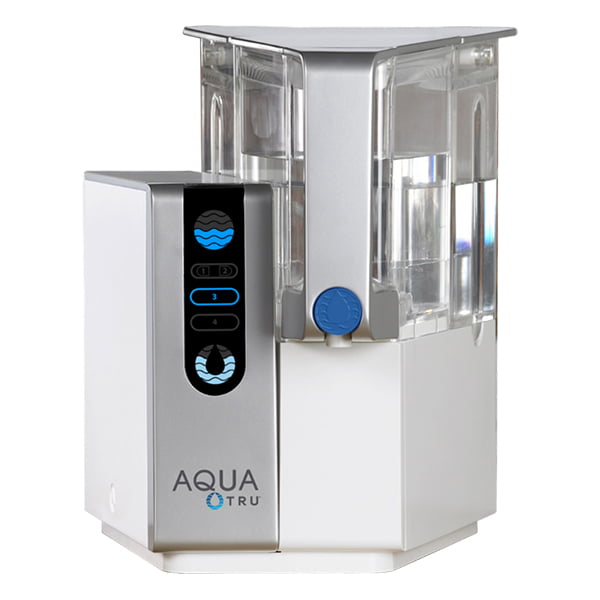
AquaTru |
|
| Price: | $$$ |
| Filter Stages: | 4 |
| Flow Rate: | 1 Gallon in 10-15 Minutes |
| NSF: | 42, 53, 58, 401, P473 |
| Annual Cost: | ~$100-120 |
|
Overall Rating: 4.5/5.0 ⓘRating based on filtration performance, filter life, price and yearly cost, NSF testing/certification, customer support, product warranty, our testing/experience, user feedback, and other factors.
Get 15% Off! Use Code: |
|
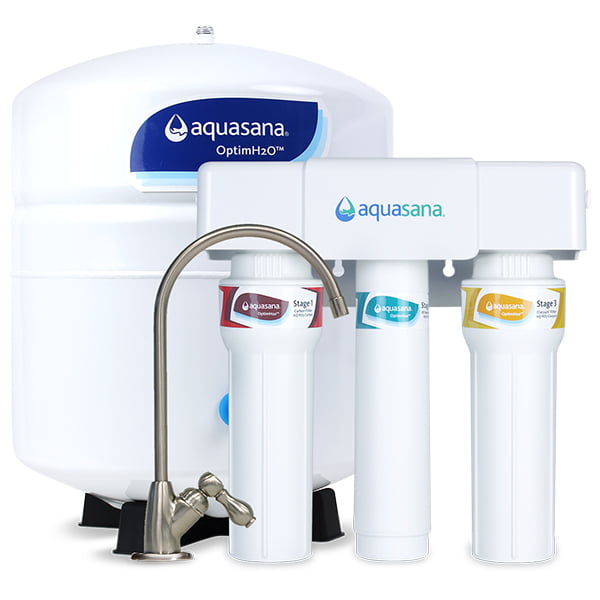
Aquasana OptimH2O |
|
| Price: | $$ |
| Filter Stages: | 4 |
| Flow Rate: | Not Specified |
| NSF: | 42, 53, 58, 401, P473 |
| Annual Cost: | ~$240 |
|
Overall Rating: 4.5/5.0 ⓘRating based on filtration performance, filter life, price and yearly cost, NSF testing/certification, customer support, product warranty, our testing/experience, user feedback, and other factors.
|
|
The AquaTru (full review here) is a countertop RO system that requires no installation. It uses a sediment filter, activated carbon, and an RO membrane to remove contaminants. And it doesn’t just claim to remove them. The AquaTru is NSF-certified against standards 42, 53, 58, 401, and P473 for reducing over 80 pollutants. It removes lead (99.1%), chromium-6 (97.2%), fluoride (93.5%), cysts (99.99%), PFOA and PFOS (97.5%), and much more. It also has nice features like an internal pump that reduces wastewater down to 20% (even better than the Waterdrop) and affordable + easy-to-change filters.
Aquasana’s OptimH2O (full review) is a tanked under sink RO system. It’s also NSF-tested and certified to remove over 90% of various contaminants like chlorine/chloramine (97.66%), mercury (>95.8%), lead (99.3%), VOCs (~99.4%), pentavalent arsenic (97.6%), chromium-6 (97.0%), fluoride (95.7%), overall TDS (95%), BPA (98.9%), and PFOA & PFOS (96%). It uses a strong combination of filters, including a sediment pre-filter, catalytic carbon, ion exchange resin, and the RO membrane. On top of that, the Aquasana OptimH2O gives your water a fine finish by enriching it with minerals that improve taste and balance pH after filtration.
In all, Waterdrop G3P600, Aquasana OptimH2O, and AquaTru are all high-efficiency systems. But the Aquasana OptimH2O is more difficult to install (kind of expected because it has a tank) and more costly to maintain (about $180-220 per year). It’s also the system that wastes the most water. Personally, we like the AquaTru best because it combines NSF certified filtration with ease-of-use and efficiency.
This completes our review of the Waterdrop G3 Reverse Osmosis System. If you have any questions please don’t hesitate to leave a comment below!
Information provided on BOS is for educational purposes only. The products and services we review may not be right for your individual circumstances.
We adhere to strict editorial guidelines. Rest assured, the opinions expressed have not been provided, reviewed, or otherwise endorsed by our partners – they are unbiased, independent, and the author’s alone. Our licensed experts fact-check all content for accuracy. It is accurate as of the date posted and to the best of our knowledge.


